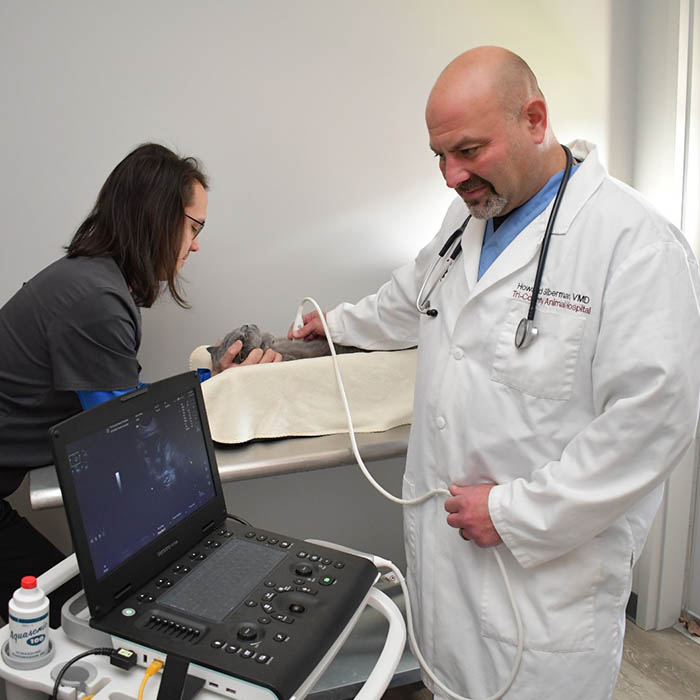What You Need to Find Out About Veterinary Providers: An Introduction of Diagnostic Tools and Procedures
Veterinary services play a crucial function in maintaining the wellness of animals. Routine exams can disclose concealed health and wellness issues early on. Different analysis devices and procedures, such as blood tests and imaging strategies, provide important understandings into an animal's wellness. Recognizing these techniques is vital for family pet proprietors. What certain diagnostic procedures are most typically utilized, and just how can they impact a pet dog's therapy plan?
Significance of Routine Vet Exams
While lots of animal proprietors might ignore the relevance of routine veterinary examinations, these appointments are vital for keeping a pet's overall wellness. Regular brows through to the vet enable very early detection of prospective health concerns before they intensify into major problems. Normal examinations often include vaccinations, which are necessary for protecting against contagious illness that can significantly influence a pet's well-being. Furthermore, these appointments offer a possibility for vets to evaluate the pet's weight, oral wellness, and total problem, guaranteeing that the pet dog is thriving. Throughout these brows through, family pet owners can likewise get beneficial recommendations on diet regimen, exercise, and preventive care customized to their details family pet's requirements.
Common Analysis Procedures in Vet Medication
In vet medication, accurate diagnosis is necessary for effective treatment. Common diagnostic treatments consist of blood testing methods, advanced imaging innovations, and urinalysis, each playing a significant duty in identifying wellness issues. Understanding these techniques improves the capability to supply ideal look after pet individuals.
Blood Examining Techniques
Blood screening strategies offer as vital analysis devices in veterinary medicine, making it possible for vets to analyze the health of animals properly. These techniques include collecting blood examples to assess different components, such as white and red blood cells, platelets, and biochemical pens. Common examinations include full blood matters (CBC), which assess general health and spot infections, and biochemical panels, which analyze body organ feature and metabolic condition. In addition, serological tests can determine specific illness through antibody detection. Blood screening is minimally invasive and supplies essential details that aids in identifying problems, keeping an eye on wellness status, and examining responses to treatments. Generally, these strategies play a crucial duty in making sure perfect take care of animals and livestock alike.
Imaging Technologies Utilized
Diagnostic imaging technologies are essential tools in veterinary medicine, complementing blood testing strategies by providing visual insights right into an animal's inner structures. Usual imaging methods include X-rays, which are valuable for assessing bone cracks and finding international things, and ultrasound, which permits real-time visualization of soft tissues and organs. Magnetic vibration imaging (MRI) provides detailed pictures of complex anatomical locations, especially in neurological analyses. Computed tomography (CT) supplies cross-sectional images, boosting diagnostic precision for numerous problems. Each of these innovations aids vets in identifying illnesses, preparing therapies, and monitoring recuperation. By integrating imaging technologies, vet professionals can much better evaluate a pet's health and make informed choices regarding their treatment.
Urinalysis and Diagnostics
Urinalysis functions as a crucial diagnostic device in vet medication, offering useful insights into an animal's total health and wellness and assisting in the detection of different conditions. This non-invasive procedure assesses urine examples to evaluate kidney feature, hydration standing, and metabolic conditions. Usual components analyzed consist of particular gravity, pH levels, glucose, healthy proteins, and the visibility of blood or microorganisms. Abnormal searchings for can indicate concerns such as urinary system infections, diabetes mellitus, or kidney condition. To enhance analysis accuracy, urinalysis is often done together with various other tests, such as blood job and imaging studies. Early discovery through urinalysis can bring about timely treatments, enhancing the diagnosis for numerous vet individuals. Consequently, it is an essential facet of thorough vet care.
Understanding Blood Tests and Lab Analysis
Comprehending blood tests and research laboratory evaluation is crucial in vet medication as it assists in identifying various health and wellness problems in pets. Different kinds of blood tests give vital details about an animal's inner state, while translating lab results calls for mindful consideration of various aspects. This section will certainly discover the types of blood tests readily available and the relevance of their outcomes.
Kinds Of Blood Examinations
Blood examinations play an important role in veterinary medicine, supplying vital understandings right into a pet's health and wellness status. Various sorts of blood examinations are used, each serving various purposes. Full blood matters (CBC) evaluate general wellness and identify problems such as anemia or infection. Biochemical accounts review body organ feature by determining electrolytes and enzymes, supplying understandings into metabolic health. Serological examinations recognize certain antibodies or virus, helping in the diagnosis of infections or autoimmune conditions. Blood inputting assurances safe transfusions, while coagulation examinations assess the blood's capability to clot, essential for medical procedures. These examinations collectively enhance medical diagnosis, therapy planning, and surveillance of an animal's wellness, highlighting the significance of complete laboratory evaluation in veterinary treatment.

Interpreting Lab Results
A comprehensive analysis of lab outcomes is essential for exact medical diagnosis and treatment in veterinary medicine. Analyzing laboratory results needs an understanding of typical referral ranges and the importance of discrepancies. Blood tests can reveal various wellness indications, such as organ feature, electrolyte equilibrium, and the presence of infections. Vets need to take into consideration the entire scientific image, including the animal's history, checkup searchings for, and any symptoms offered. Variants in outcomes might arise from factors such as age, breed, and underlying health conditions. Laboratory outcomes need to not be checked out in isolation yet instead as part of an all-encompassing diagnostic approach. Precise interpretation enables tailored therapy plans and far better results for vet people.
Imaging Techniques: X-rays, Ultrasounds, and Beyond
Imaging techniques are important devices in veterinary medication, giving essential understandings right into the health and wellness and health of animals. Amongst the most typically used methods are Ultrasounds and x-rays. X-rays are very useful for envisioning bone structures, aiding vets identify cracks, growths, or international items. This method is fast and non-invasive, making it excellent for urgent situations.Ultrasounds, on the various other hand, utilize acoustic waves to produce pictures of soft tissues and organs. This method is particularly valuable for checking out the heart, abdominal area, and reproductive body organs, enabling veterinarians to assess problems like liquid accumulation or check here organ abnormalities.Beyond X-rays and ultrasounds, progressed imaging methods such as computed tomography (CT) and magnetic resonance imaging (MRI) are increasingly used in vet technique. These techniques offer thorough cross-sectional pictures, improving the accuracy of diagnoses and therapy plans. CT Scans For Animals. Overall, imaging methods play an essential duty in making certain effective veterinary treatment
The Function of Biopsies in Diagnosing Pet Health Issues
Precision in detecting health and wellness issues in pet dogs typically depends upon making use of biopsies, which give definitive details concerning cells irregularities. A biopsy entails the elimination of a tiny example of cells for examination under a microscope, allowing veterinarians to identify various conditions, consisting of infections, growths, and inflammatory illness. This analysis tool is necessary for comparing deadly and benign developments, leading treatment decisions, and reviewing the seriousness of a condition.Biopsies can be done utilizing various techniques, such as needle goal, incisional biopsies, or excisional biopsies, depending visit site upon the area and kind of cells entailed. The selection of technique might influence recovery time and the quantity of tissue gathered. Eventually, the info gleaned from a biopsy can result in targeted therapies, improving outcomes for pet dogs encountering significant wellness difficulties. Veterinarians emphasize the relevance of this treatment in attaining exact medical diagnoses and reliable treatment strategies.
Advanced Diagnostic Devices: Endoscopy and CT Checks

Advanced diagnostic tools, such see this here as endoscopy and CT scans, play a crucial role in modern veterinary medicine, offering non-invasive techniques to imagine internal frameworks and identify numerous conditions in family pets. Endoscopy involves the use of an adaptable tube equipped with an electronic camera, enabling vets to analyze the intestinal tract and respiratory system directly. This method can reveal irregularities such as growths, foreign bodies, or inflammation, enabling targeted therapy plans.CT scans, on the other hand, make use of advanced imaging modern technology to produce in-depth cross-sectional pictures of the body (CT Scans For Animals). This technique is especially useful for assessing complex structures like the mind, back, and joints. By offering high-resolution photos, CT scans help veterinarians in identifying concerns that may not appear with conventional radiography. With each other, these advanced devices boost analysis precision, boost treatment results, and inevitably add to much better overall family pet health and wellness monitoring

Interpreting Test Outcomes: What Pet Dog Owners Must Know
Recognizing test results can be a challenging job for pet proprietors, specifically after advanced treatments like endoscopy and CT scans have actually been performed. Interpreting these results calls for a grasp of medical terms and a clear understanding of what the searchings for indicate concerning the pet's health and wellness. Veterinarians commonly offer explanations, however the intricacy of the results can still lead to confusion.Pet owners must proactively participate in conversations with their vets, asking questions to clear up any unpredictabilities. It is important to understand abnormal versus normal outcomes and the effects for the family pet's treatment strategy. Additionally, identifying that some outcomes may require further testing or tracking can help proprietors stay educated about their pet dog's wellness trip. Ultimately, a collective approach between family pet owners and veterinary professionals fosters better wellness outcomes and improves the general care experience for animals.
Often Asked Concerns
Just how Do I Choose the Right Veterinary Center for My Pet dog?
Picking the appropriate vet facility entails looking into local options, examining qualifications, going to facilities, and analyzing team interactions (Ultrasound For Dogs). Focusing on suggestions from relied on sources can assist guarantee the most effective treatment and environment for an animal's health and wellness needs
What Should I Do if My Pet Dog Refuses to visit the Vet?
When a pet declines to visit the veterinarian, it's a good idea to continue to be tranquil, usage deals with or playthings to entice them, and take into consideration scheduling a home go to if anxiousness persists. Patience and positive support are vital.
Are There Telehealth Options for Vet Services?
Telehealth alternatives for veterinary solutions are increasingly readily available, permitting animal proprietors to speak with veterinarians remotely. These services enable conversations about health concerns, guidance on small conditions, and follow-ups without needing to go to a facility.
How Frequently Should My Animal Have Oral Examinations?
The regularity of dental examinations for pet dogs usually relies on their age and type. Normally, veterinarians recommend annual oral examinations, although some animals may require more frequent sees to maintain perfect dental health.

What Are the Expenses Connected With Veterinary Diagnostics?
The prices connected with veterinary diagnostics can differ widely, generally varying from standard tests like blood work to advanced imaging strategies. Factors affecting expenditures consist of the center's place, tools made use of, and particular examinations required for each and every animal. Vet services play an important duty in keeping the health of animals. While several animal owners may underestimate the significance of regular veterinary examinations, these visits are essential for maintaining a pet's general health. Furthermore, these visits give a possibility for veterinarians to assess the pet's weight, dental health and wellness, and general condition, making certain that the animal is thriving. Accuracy in diagnosing health problems in pet dogs typically hinges on the use of biopsies, which supply clear-cut information about tissue problems. Additionally, recognizing that some outcomes may require additional screening or surveillance can help owners remain notified about their animal's health and wellness trip.